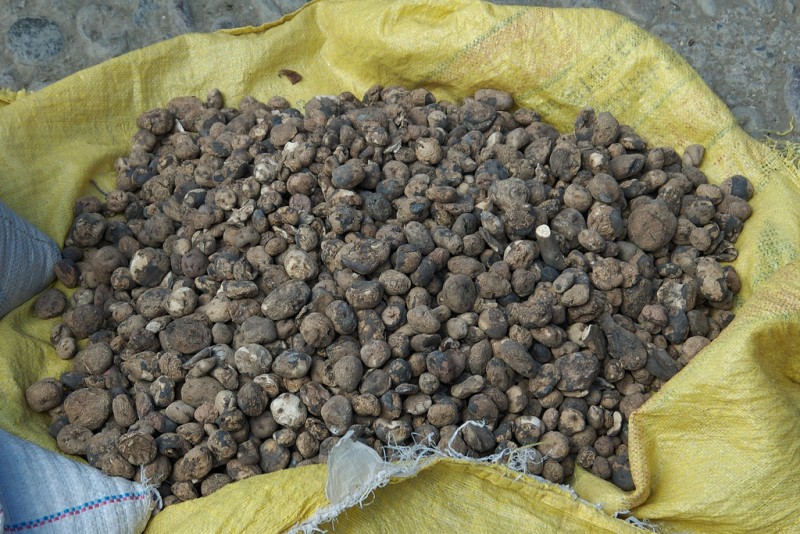
Bitter Potatoes. Paucartambo, Cusco, Peru. Photo by Eric Hunt. CC 2.0.
In last year's Hollywood film The Martian, astronaut Mark Watney, played by Matt Damon, is left for dead by his crew after being caught in a sandstorm on Mars. In order to survive, Watney plants some potatoes that NASA had sent up with his crew. In this case, science fiction isn't far from reality.
America's space agency, NASA, and the Peruvian International Potato Center (CIP), are carrying out joint experiments to test the possibility of growing the Peruvian tuber in Martian soil, according to a new report by BBC World.
Regarding the nutritional qualities of the potato, CIP says:
Hay más de 4,000 variedades comestibles de papa, la mayoría encontradas en los Andes de Sudamérica.
[…]
Aproximadamente 1.4 mil millones de personas alrededor del mundo consumen papa como alimento básico, y la producción total del cultivo sobrepasa los 300 millones de toneladas métricas.
La papa es esencial en términos de seguridad alimentaria frente al crecimiento de la población y al aumento de las tasas globales de hambre. […] La papa, primer alimento moderno de preparación rápida, es rica en energía, nutritiva, fácil de prosperar en parcelas pequeñas, barata para comprar y lista para cocinarse sin costoso procesamiento. El banco de germoplasma del CIP mantiene la colección más grande de papa del mundo, incluyendo más de 7,000 accesiones de variedades nativas, silvestres y mejoradas.
There are over 4,000 edible varieties of potato, mostly found in the Andes of South America.
[…]
About 1.4 billion people around the world eat potatoes as a basic food, and the total production of this crop exceeds the 300 million of metric tons. The potato is key when it comes to food safety in face of the population growth and the global hunger rates. […] Potatoes, the first quick-preparation modern food, are high in energy, nutritious, easy to grow in small plots, cheap, and affordable and ready to cook without costly processing. CIP's germplasm bank keeps the biggest collection of potatoes in the world, including over 7,000 accessions of native, wild, and improved varieties.
In Peru, there are 4,500 varieties of potato, and CIP is tasked with choosing which kind is best suited to the conditions on Mars.
The website Huachos.com briefly reviews the potato's history and its future prospects:
La papa fue domesticada hace unos 3.800 años, a lo largo de la ribera del lago Titicaca, entre Perú y Bolivia, y desde allí, tras la llegada de los europeos a América hace 500 años, llegó al resto del planeta. Ahora, cuando la papa es el cuarto cultivo para la alimentación del mundo, también desde Perú, se ha lanzado un proyecto para llevar el tubérculo al espacio exterior.
The potato was domesticated about 3,800 years ago, all along the banks of Lake Titicaca, between Peru and Bolivia, and from there, after Europeans arrived in America 500 years ago, it traveled all over the planet. Today, when potatoes are the fourth largest crop in the world, Peru is poised again to play a role in the potato's fate, hosting a project to take the tuber to the space.
Scientists have already started to conduct experiments with potatoes, subjecting the tuber to conditions similar to those found on Mars, with soil from the Pampas de la Joya desert in Arequipa, in Southern Peru:
“Son suelos volcánicos no contienen ninguna forma de vida en absoluto, igual que en Marte” indicó Joel Ranck, jefe de comunicaciones del CIP.
En esta primera etapa se tomarán 9 variedades de papa y se harán germinar en el suelo desértico, así como simular en un ambiente controlado la atmósfera marciana para ver cómo afecta en el crecimiento al tubérculo. Esto con el fin de saber que tan viable sería la agricultura en el planeta rojo.
“They are volcanic soils with no life forms at all, just as on Mars,” pointed out Joel Ranck, CIP communications officer.
During the first stage, nine varieties of potato have been chosen and will be grown in the desert soil, and the Martian atmosphere will be simulated in a controlled environment to see how it affects the tuber's growth. This in order to learn how viable farming could be on the Red Planet.
The Arequipan Pampas de La Joya desert is considered key, as presumibly it's similar to Mars. Already in 2009, astronauts from the International Space Station began to develop an experiment to grow seeds of Peruvian potatoes on Mars. The idea was to try to grow five varieties of potato—out of the more than 3,000 found in Peru—to determine “resistance and food versatility,” aiming to demonstrate the possibility of growing food on Mars.
The news also inspired several tweets:
Científicos intentan sembrar papa en el planeta Marte https://t.co/bktA79niOa pic.twitter.com/Su5kQG8trM
— Conecta Perú (@ConectaPeru_) enero 5, 2016
Scientists will try to grow potato in planet Mars.
#Papa peruana será primer alimento en llegar a #Marte https://t.co/Xo7EkwY1XU pic.twitter.com/fK8SuKpzpZ
— Crónica Viva (@cronica_viva) enero 5, 2016
A Peruvian potato will be the first food on Mars.
El Centro Internacional de la Papa y NASA estudian el cultivo de Papa en Marte https://t.co/GyKrJDAuRr pic.twitter.com/BlCmzJaxks — DFNS en Español (@DFNS_es) enero 5, 2016
International Potato Center and NASA study the farming of potatoes on Mars.
Papa peruana será el primer alimento en llegar a Marte https://t.co/6KX9VdiZ8x que hagan una buena salchipapa marciana y vaos en mancha (?) — Eduardo Torres (@luiseduhardo) enero 5, 2016
Peruvian potatoes will be the first food to arrive on Mars. May they prepare a good salchipapa.
(The salchipapa is a popular Peruvian homemade dish, prepared with sausages sliced into rounds, served with fried potatoes.)







2 comments
Why the sudden imperative to build a habitat to Mars and grow anything there? Given up on all the proles on earth, have you NASA?